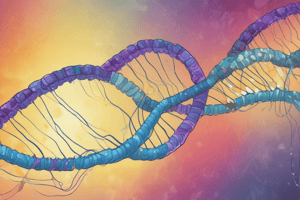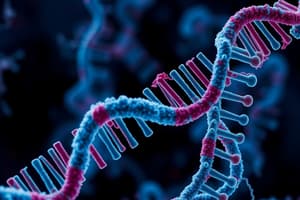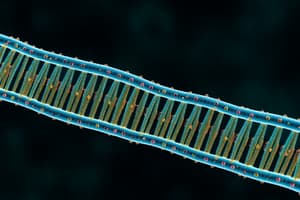Podcast
Questions and Answers
What role do exons play in RNA splicing?
What role do exons play in RNA splicing?
Exons are connected together through splicing, which modifies the RNA to produce a mature mRNA molecule.
Explain the significance of the initiation stage in translation.
Explain the significance of the initiation stage in translation.
During initiation, mRNA and ribosomes come together to form the first tRNA, marking the beginning of protein synthesis.
How does post-translation modification affect proteins?
How does post-translation modification affect proteins?
Post-translation modification can alter proteins by adding or removing chemical groups, which changes their function and expression.
What is the impact of gene expression on physical traits?
What is the impact of gene expression on physical traits?
Describe the role of eIF-2 in translation.
Describe the role of eIF-2 in translation.
What is the main function of gene expression in a cell?
What is the main function of gene expression in a cell?
How does gene expression differ between prokaryotic and eukaryotic cells?
How does gene expression differ between prokaryotic and eukaryotic cells?
What role do transcription factors play in gene expression?
What role do transcription factors play in gene expression?
Explain the role of the lac operon in the regulation of gene expression.
Explain the role of the lac operon in the regulation of gene expression.
What are introns and exons, and how do they relate to RNA splicing?
What are introns and exons, and how do they relate to RNA splicing?
What environmental factors can affect gene expression and provide an example?
What environmental factors can affect gene expression and provide an example?
Describe the process of transcription and its importance in gene expression.
Describe the process of transcription and its importance in gene expression.
What happens to the repressor in the presence of lactose, and why is this significant?
What happens to the repressor in the presence of lactose, and why is this significant?
Flashcards
RNA splicing
RNA splicing
The process of removing introns and connecting exons in messenger RNA (mRNA).
eIF-2
eIF-2
A protein that helps initiate translation by bringing mRNA and ribosomes together.
Translation
Translation
The process where mRNA is used as a template to create a chain of amino acids, called a polypeptide.
Initiation (translation)
Initiation (translation)
The stage of translation where the ribosome and tRNA assemble to read the first codon in the mRNA.
Signup and view all the flashcards
Elongation (translation)
Elongation (translation)
The stage of translation where the ribosome moves along the mRNA, adding amino acids to the growing polypeptide chain.
Signup and view all the flashcards
Gene Expression
Gene Expression
The process by which a gene is used to create a functional protein. It is regulated by various factors and not all genes are expressed at all times.
Signup and view all the flashcards
Gene Expression in Prokaryotes
Gene Expression in Prokaryotes
The control of gene expression in prokaryotes is simpler than eukaryotes because they lack a nucleus. Transcription and translation occur simultaneously, giving fewer opportunities for regulation.
Signup and view all the flashcards
Gene Expression in Eukaryotes
Gene Expression in Eukaryotes
Eukaryotic gene expression is more complex due to the presence of a nucleus, separating transcription and translation. This allows for more control over gene expression.
Signup and view all the flashcards
Transcription Factors
Transcription Factors
A regulatory protein that attaches to specific DNA regions, either stimulating or inhibiting the process. This is a key mechanism controlling gene expression.
Signup and view all the flashcards
Promoter
Promoter
A region of DNA that acts as a binding site for RNA polymerase, initiating transcription. Other proteins can bind to the promoter to prevent RNA polymerase from binding and stop transcription.
Signup and view all the flashcards
Enhancer
Enhancer
DNA regions that increase the rate of transcription by binding to specific proteins, which then interact with other proteins to enhance RNA polymerase activity.
Signup and view all the flashcards
Repressor
Repressor
A protein that binds to DNA and blocks RNA polymerase from initiating transcription, preventing gene expression. They act as a negative regulator of gene expression.
Signup and view all the flashcards
Lac Operon
Lac Operon
A model used to explain how bacteria control the expression of genes involved in lactose metabolism. The lac operon is regulated by a repressor protein that binds to an operator site, blocking transcription when lactose is absent.
Signup and view all the flashcardsStudy Notes
Gene Expression
- Gene expression is the process of using a gene to make a functional protein.
- Not all genes are expressed in all cells.
- Gene expression is regulated to ensure that the correct genes are expressed at the correct time and in the correct place.
Prokaryotic Gene Expression
- Prokaryotic cells have relatively simple gene expression machinery.
- Transcription and translation occur in the cytosol (outside the nucleus).
- Control of gene expression is primarily at the transcriptional level.
- Gene expression in prokaryotes mainly involves the regulation of transcription.
- Transcription happens, then translation
- Control of gene expression affects transcription/translation.
Eukaryotic Gene Expression
- Eukaryotic cells have a more complex gene expression machinery.
- Transcription occurs in the nucleus, and translation in the cytoplasm (outside the nucleus).
- Eukaryotes have more opportunities for gene regulation than prokaryotes due to the compartmentalization of transcription and translation.
- Gene expression is regulated at many stages, including transcription initiation, mRNA processing, and translation.
- Transcription - when an RNA polymerase makes a copy of a gene's DNA sequence.
Transcription Factors
- Transcription factors are proteins that bind to DNA and regulate the transcription of genes.
- Promoters help RNA start transcription.
- Other transcription factors attach to stop it.
- Enhancers increase transcription.
- Repressors block RNA polymerase from forming transcription.
Environmental Influences
- Environmental factors, like UV light, lack of nutrients, and excess quantities of substances, can affect gene expression.
Example: Lac Operon
- Lactose utilization in bacteria.
- The lac operon regulates the expression of genes that break down lactose.
- When lactose is not present, the repressor binds to the operator, preventing transcription.
- When lactose is present, it binds to the repressor, causing it to detach from the operator and allowing transcription.
Gene Regulation in Eukaryotes
- Transcription in eukaryotes involves more steps. RNA polymerase makes a DNA copy called mRNA, a messenger RNA.
- Post-transcriptional modifications, like mRNA splicing, occur before translation.
- Introns (non-coding regions) are removed, and exons (coding regions) are joined together through splicing.
- This splicing can affect the resulting protein.
Translation
- Translation is the process of translating mRNA into a polypeptide chain (protein).
- Initiation involves bringing together mRNA and ribosomes to create the first tRNA.
- Elongation involves bringing amino acids to the ribosome by tRNA.
- Termination occurs when polypeptide chains are released.
- Post-translational modifications can occur after translation is complete.
Importance of Gene Expression
- Gene expression controls a variety of traits, such as height, eye color, blood type, and hair color.
- Disruptions to gene expression can lead to disease such as cancer.
- Mutations can increase the rate of translation of genes, which can speed up cell division, and increase the production of cancer cells.
Studying That Suits You
Use AI to generate personalized quizzes and flashcards to suit your learning preferences.




